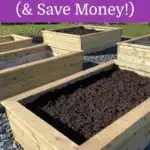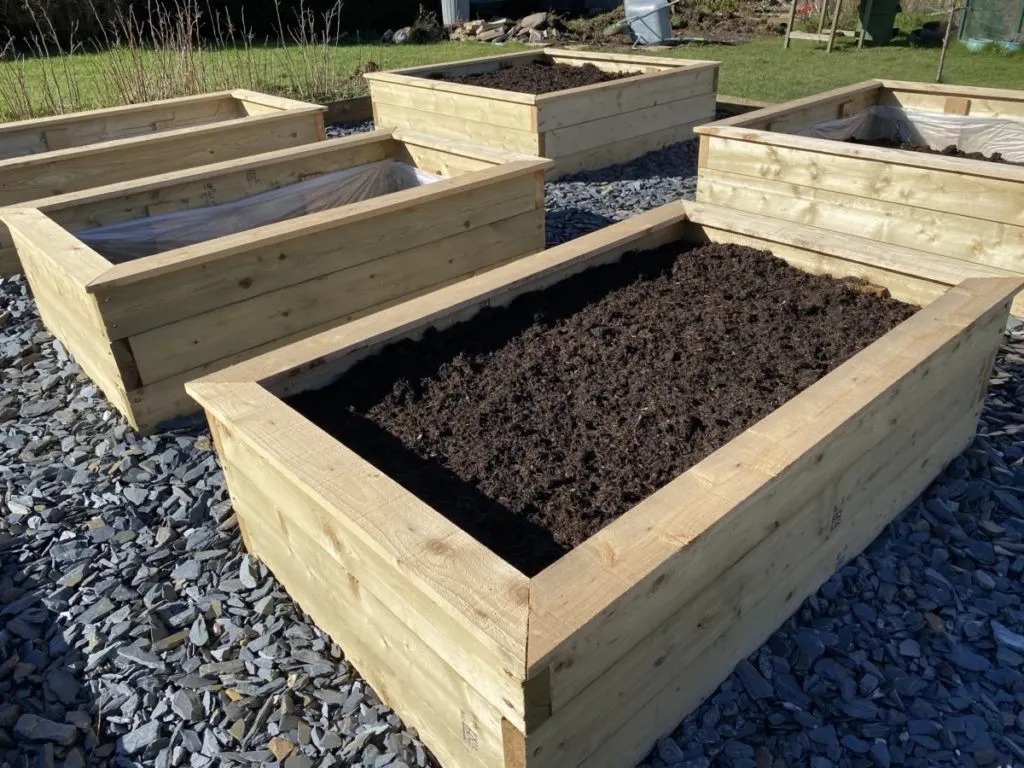
You’ve built yourself a raised bed (or maybe you’ve put together one of these ready made kits), you’ve avoided all the common raised bed mistakes, but now it’s time to start filling with healthy growing medium so you can enjoy abundant harvests in summer.
But what exactly do you fill it with? Let’s take a look…
Soil isn’t some inert and lifeless thing.
Healthy soil is positively bursting with life – most of which cannot be seen with the naked eye. Each tablespoon of rich and loamy soil contains more living organisms than there are humans on the planet!
Bacteria, algae, lichens, fungi, protozoa, and nematodes are too tiny to see but spotting earthworms and insects crawling through the earth are good indications that the soil is healthy and fertile.
The presence of microscopic organisms in soil is beneficial in many ways.
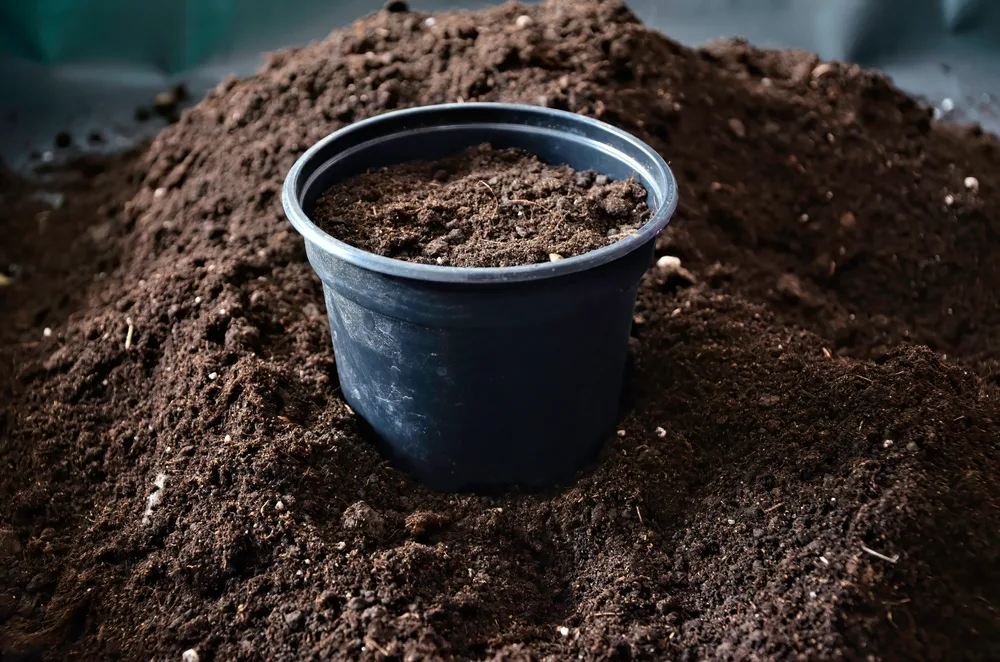
Soil-dwelling bacteria and fungi facilitate the nutrient cycle by breaking down organic matter, making key nutrients available for plants to absorb.
They produce gummy substances that improve soil structure by binding clay, sand, and silt particles together. Like nature’s glue, it keeps soil from completely crumbling when handled, washing away when it rains, or dispersing like sand in the wind.
As more and more masses of soil particles are bound together, they become larger clumps known as soil aggregates. Spaces between soil aggregates create vast networks, held together by thread-like fungal filaments. These tiny tunnels allow air, water, and nutrients to flow through the soil.
Soil microbes are also a natural defense against weeds, pests, and disease. They have the power to change the characteristics of the soil itself, by lowering pH and increasing oxygen levels near the soil surface. This creates an environment less hospitable for unwanted plants and harmful bacteria.
The area of soil surrounding the roots of plants – known as the rhizosphere – is a truly awe-inspiring place that is worthy of our attention and care. The complex – and mostly invisible – interactions between these underground organisms is a part of the greater soil food web that makes all of life possible.
How Much Soil Do I Need To Fill My Raised Bed?
Filling your raised bed needn’t be guess work. There is a simple calculation to work out exactly how much material you’ll need.
Use this soil calculator to determine the volume of materials you will need to fill each raised bed.
The Recipe for Healthy Soil
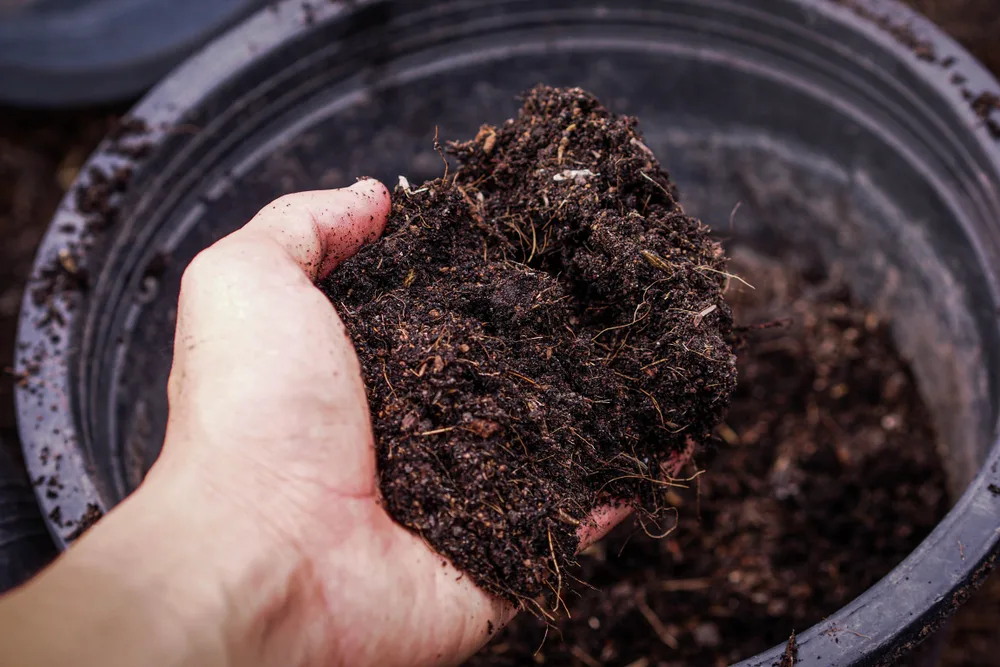
Good soil is the bedrock of a healthy and productive garden. When you pay proper homage to your growing medium by ensuring it harbors plenty of living organisms, you’ll be amply rewarded in the vegetable patch!
One big advantage of gardening in raised beds is complete control over the quality and characteristics of your soil.
By starting from scratch in an empty bed, you can choose exactly what the soil will be composed of. This means you can fine-tune your mix to attain the perfect organic growing medium for your specific biome.
The base recipe for rich and fertile soil is amazingly simple:
50% Topsoil / 50% Compost
This straightforward and balanced formula will produce excellent results in the garden.
The 1:1 ratio can be a starting point too. Feel free to tinker and adjust amounts to customize your mix.
Gardeners in rainy climates, for example, may want the soil to drain freely. Those residing in arid zones might prioritize moisture retention.
Adjust the basic formula by adding individual amendments in 5% increments, up to a total of 20%. This would make your final blend closer to 40% topsoil, 40% compost, and 20% extra materials (which we will cover later).
Topsoil – 50%
Topsoil is a tricky thing to define.
It is technically the outermost layer of soil along the earth’s surface, anywhere between 2 to 12 inches below ground. True topsoil is a very valuable material since it is enriched with all sorts of living, dead, and decaying organic matter.
But because there is no actual legal definition of what topsoil is, topsoils available for purchase may not be “true” and won’t necessarily contain nutrients or microbial life.
This is why topsoil acts as more of a volume filler in raised beds. Because compost will be added to the mix, you don’t need to rely wholly on topsoil to provide nutrients and soil microbes for the plants.
It’s always wise to get the best topsoil quality you can for your budget. This will help build the overall health of your soil and give the raised garden a fantastic head start.
Bulk Topsoil
When you have several raised beds to fill, buying topsoil in bulk is the most economical choice.
Bulk topsoil is purchased by the cubic yard. It is delivered by dump truck and deposited onto a spot on your property.
High quality topsoil will have a dark brown and loamy texture. It should be clean, screened, and free of debris.
Use only reputable landscaping companies when sourcing topsoil for large projects. Before buying, visit the seller and give the topsoil a squeeze. Good topsoil should hold together but break apart when poked.
Beware of low quality, bare bones topsoil that does not contain any organic matter at all. It will fall apart easily when squeezed and is essentially just dirt.
Most sellers offer topsoils blended with compost, peat moss, or black loam as well. Blended topsoils will have a much richer texture and a good earthy aroma, thanks to the addition of organic matter.
Another thing to bear in mind is topsoil will most certainly contain weed seeds. This really can’t be helped because the high heat needed to destroy all the seeds would kill off any beneficial organisms in the soil too.
Bagged Topsoil
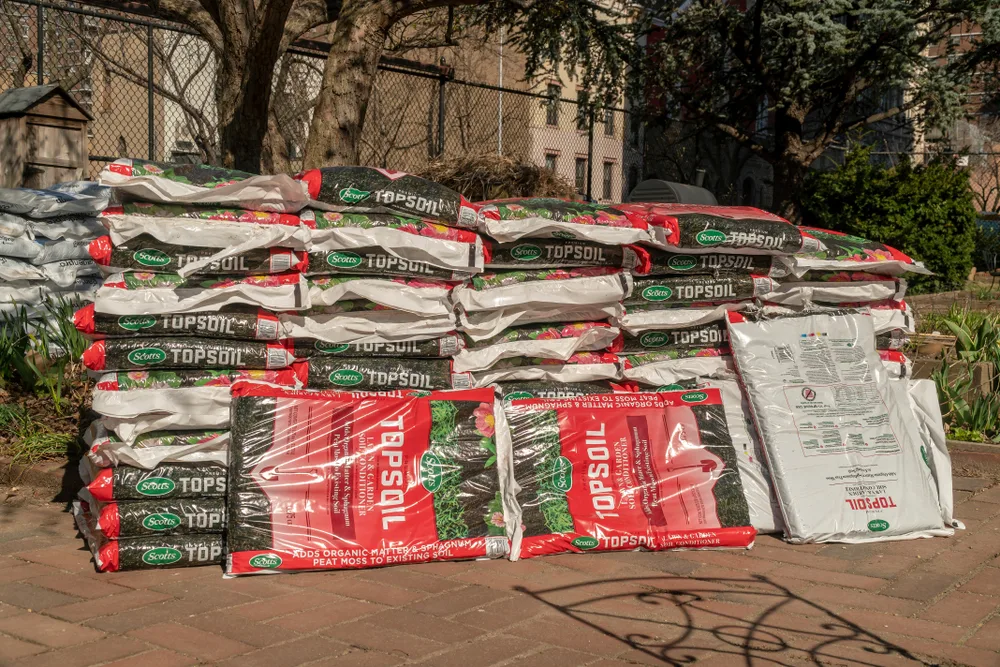
When you have only one or two raised garden beds to fill, purchasing topsoil by the bag is more convenient (and a lot less messy) than buying in bulk.
Still, there is a bewildering amount of choice in the soil departments of most garden centers. You’ll see bags labelled as topsoil, garden soil, raised bed soil, and potting mixes – to name a few. The differences between these soil types comes down to their ingredients:
Topsoil
Basic topsoils are typically composed of clay and sand. They are dry and gritty, and lack any organic matter whatsoever.
At less than $2 per 40-pound bag, basic topsoil is the cheapest option but will need to be heavily amended with compost and other materials to make it fit for growing.
Premium Topsoil
Premium topsoil is basic topsoil with a small amount of forestry products – like sawdust and pine shavings – that help give the soil a bit more structure. Some premium topsoils come mixed with a little peat moss for better water retention.
For under $3 per 0.75 cubic foot bag, it is a decent and cheap topsoil option for raised beds.
Garden soil
Garden soil is more so intended for in-ground gardens, but is also perfectly fine to use as less pricey raised bed filler.
Like premium topsoil, garden soil contains peat moss and woody matter, but in greater amounts. It costs about $4 per 0.75 cubic foot bag.
Raised bed soil
A newer product on the market is raised bed soil. This contains finely shredded hardwood with lots of peat moss.
At around $8 for 1.5 cubic foot bag, it costs about the same as garden soil but has a higher peat moss ratio.
Potting mix
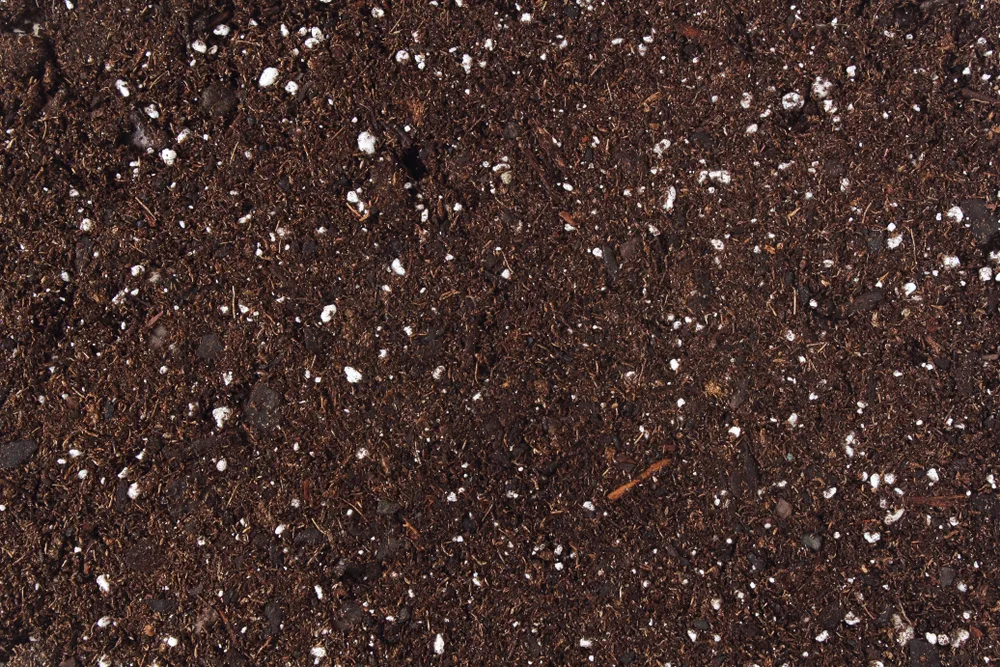
Most potting mixes are made up of mostly peat moss with varying amounts of woody materials, vermiculite, perlite, and fertilizers. It’s typically very loose and fluffy, and will hold moisture while still draining well.
Potting mix is more suitable for container gardens, and less so for filling the bottom of raised beds.
Each 2.5 quart bag costs $10 or more, so it is also the priciest way to fill up a raised bed.
Native Soil
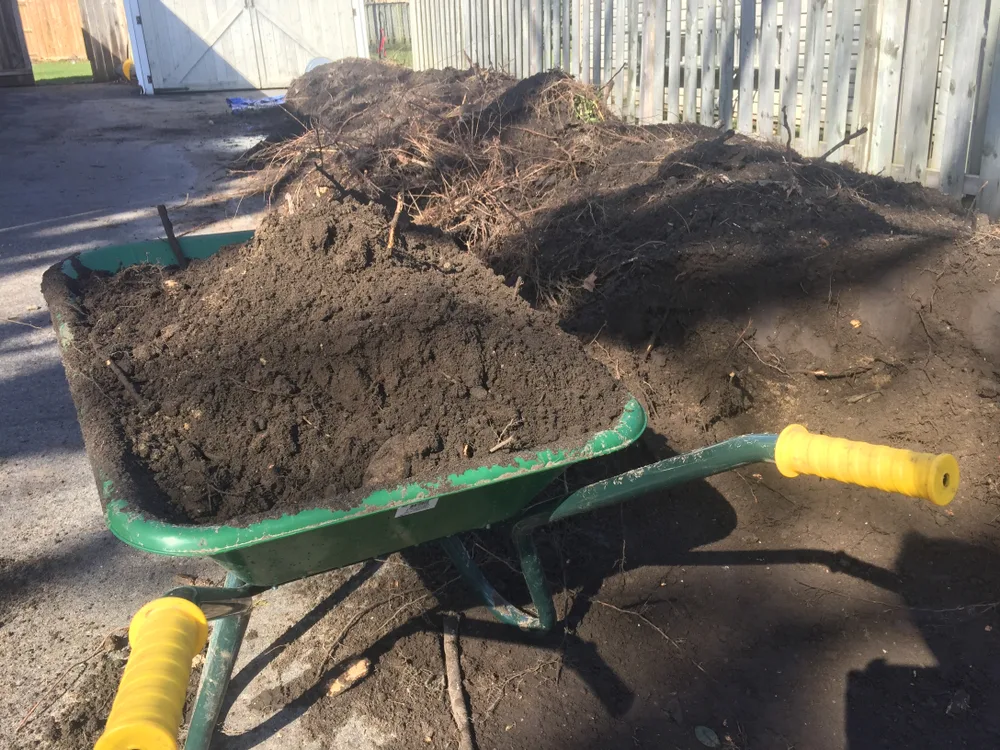
The cheapest topsoil and raised bed filler is definitely the soil that already exists on your property.
Only use native soil in raised beds if you are reasonably certain it is free of soil-borne diseases and pests.
You can assess the tilth of the soil by giving it a squeeze. Smell it deeply. Run your fingers through it when it is both wet and dry.
Native soil that is predominantly sand or clay can be mixed with a small amount of compost to improve texture.
Getting the feel of good soil is a valuable skill for the gardener to learn. When in doubt, you can always have your soil tested for N-P-K values, pH levels, micronutrients, soil texture, and organic matter.
Compost – 50%
Compost is an absolutely essential part of the equation for healthy soil since it’s what seeds the garden with nutrients and microbial life.
Well-rotted compost is highly fertile and will provide an array of micro and macro nutrients plants need to thrive. It also fixes poor soil in numerous ways by conditioning it, buffering pH levels, and boosting moisture retention.
Homemade Compost
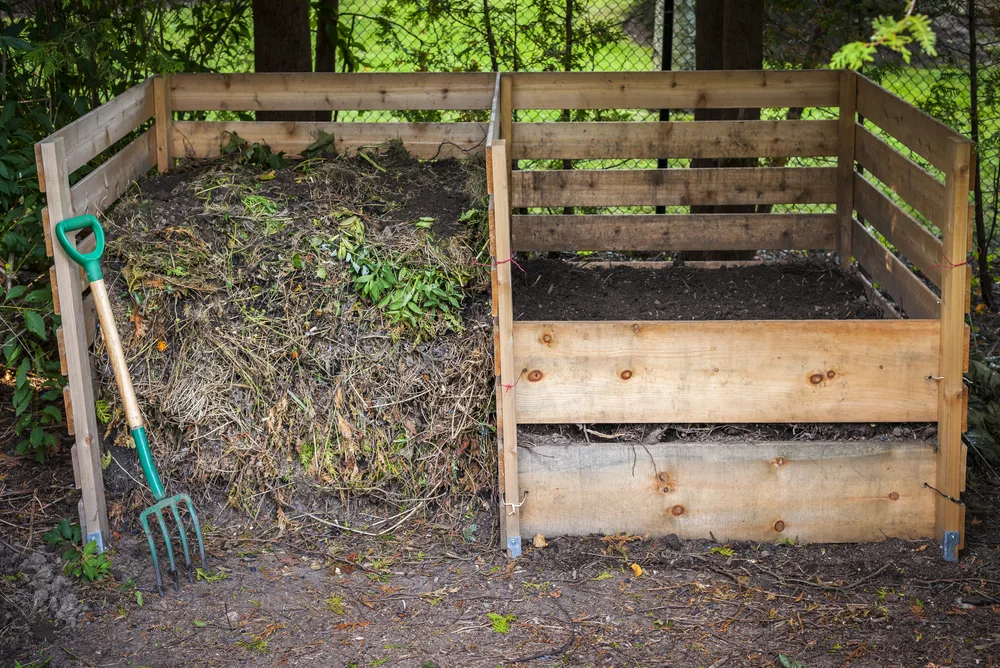
Starting up a heap in your backyard is really the best way to obtain compost of the highest quality.
By making the compost yourself, you will have total control over what organic materials you want to use to feed the pile. This way you can be sure it’s completely organic and clean.
And it’s pretty much free!
Tons of household waste can be transformed into black gold. Using the rapid composting method, you can turn kitchen and yard scraps into finished compost in as little as 14 to 21 days.
For larger projects – like filling up a slew of raised beds – you will need to process quite a lot of organic materials to provide enough compost volume.
Multi-bay compost bins are ideal for generating plenty of compost in a short amount of time. You’ll need to have an abundance of green and brown materials on hand to keep it well fed and working.
Even so, there never seems to be enough compost to go around the garden. It’s fine to supplement what you have with compost from other sources.
Certified Compost
Because compost plays such a vital role in building healthy soil, you will want to make sure what you use is real, fertile, and safe for the garden.
This is especially important when adding compost to the soil around edible plants. The compost you buy should be – at least, in theory – good enough to eat. Growing crops in bad compost could lead to pathogens or heavy metals contaminating the foods you grow.
For peace of mind, only use compost that has been STA Certified for quality assurance. Certified compost is regularly tested and meets specific standards for quality and safety.
Here is the complete list of suppliers located across the US that carry Certified compost.
Vermicompost
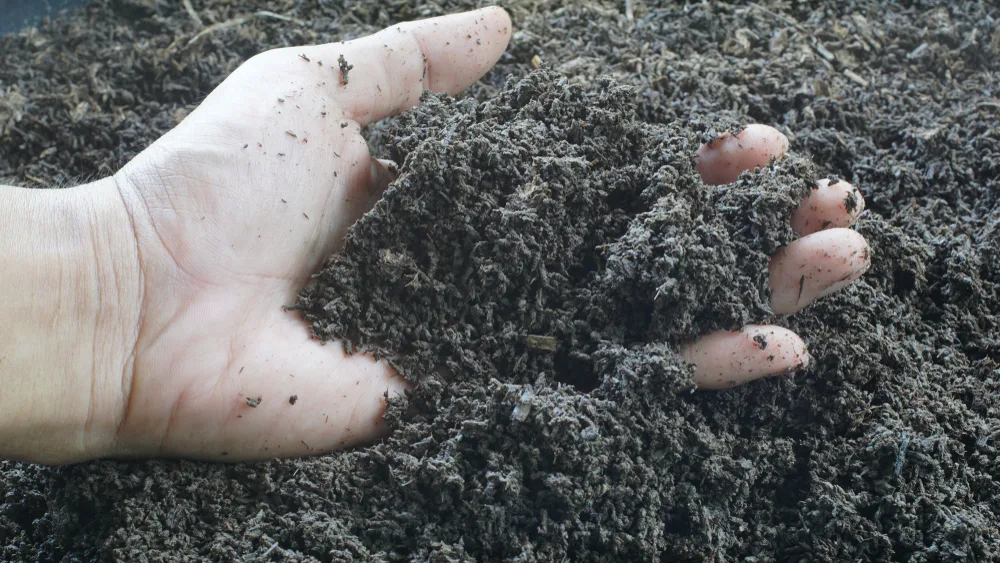
Vermicompost – also known as worm castings or simply worm poo – is another option for creating great soil in your raised beds.
Like traditional compost, worm castings are incredibly rich in nutrients and beneficial microbes. When mixed with topsoil, vermicompost improves soil structure, aeration, and water holding capacity.
Starting up a wormery makes for a fun and fascinating side project that will keep you in worm castings year-round. It’s a good composting alternative for smaller gardens and apartment dwellers since the worm bin can be situated indoors.
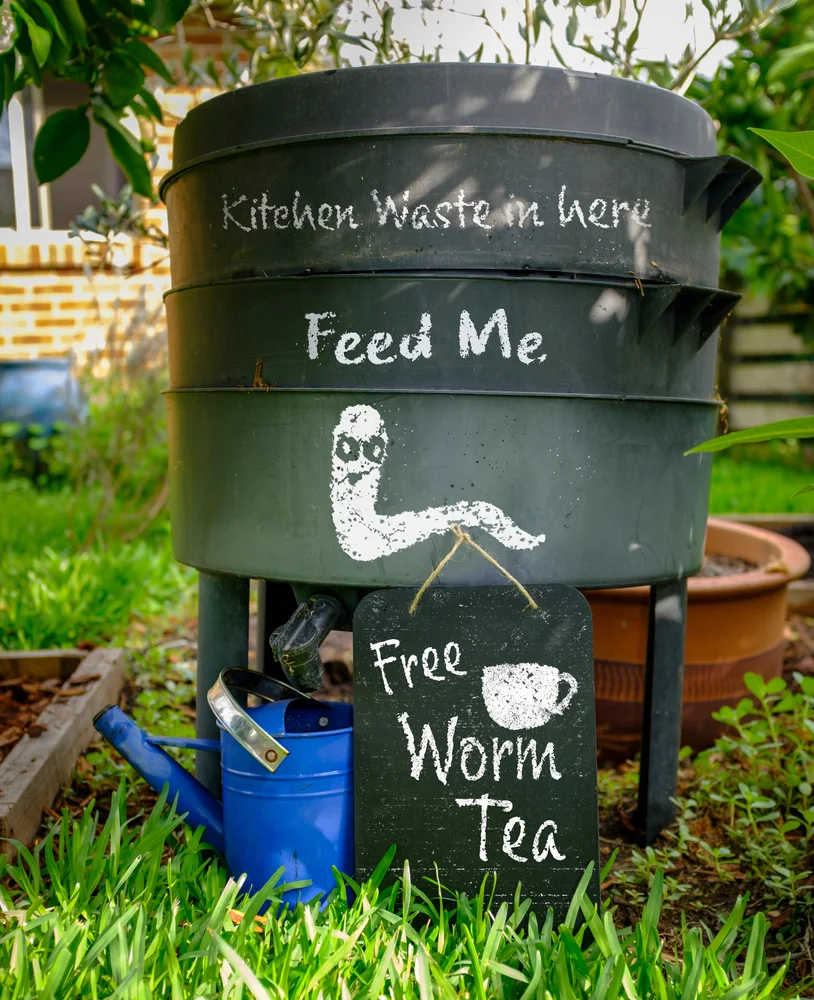
Worm castings are more nutrient-dense than traditional compost and you may find a little goes a long way. Start with about 30% worm castings when adding it to the topsoil for raised beds.
Vermicompost can be used throughout the growing season to give plants a considerable boost. Do so by side dressing around each plant or between rows.
You don’t necessarily need a worm bin to enjoy the benefits of vermicompost either. You can often find worm castings for sale at garden centers. If you can’t find some locally, check for trustworthy brands online – like this 10-pound bag of earthworm castings by VermisTerra.
Optional Extras – Up to 20%
To really customize your raised bed mix, add in extra organic matter at a rate of 5% each to increase drainage, aeration, and / or moisture retention.
These ingredients are completely optional but including them in your final recipe will only improve the condition of your soil.
Leaf Mold
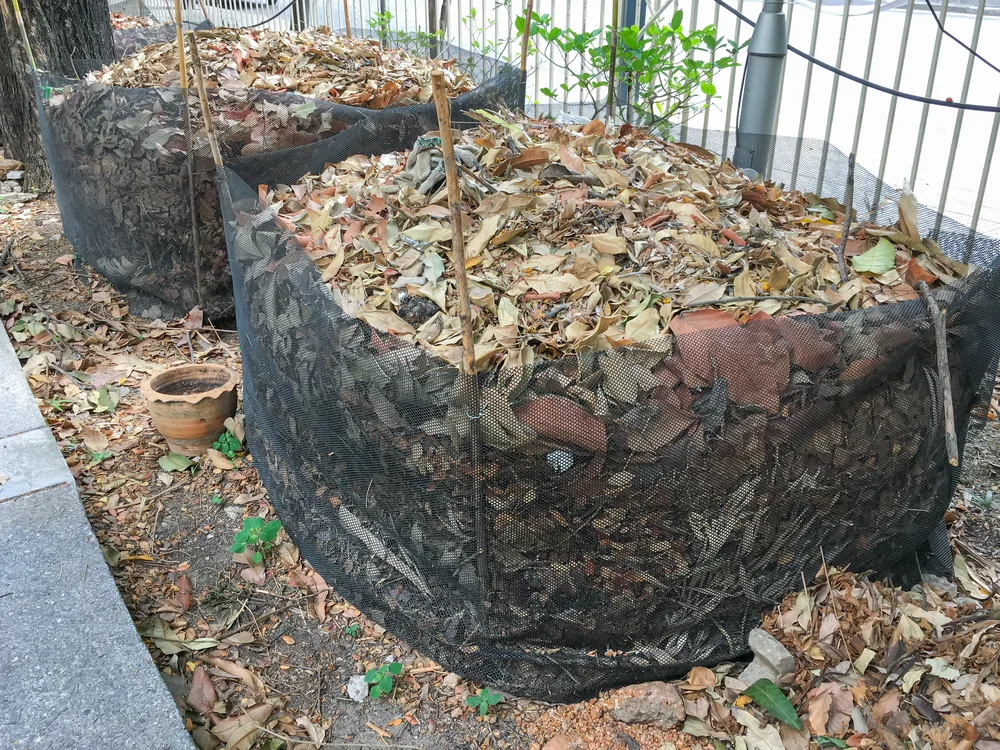
Leaf mold acts as a soil conditioner, while also bumping up the moisture holding properties of soil. It’s free and easy to make yourself – here’s how.
Sphagnum Peat Moss
Somehow peat moss has the amazing ability to both hold water and assist with aeration. Only include peat moss in your mix if the topsoil you use contains very little (or no) peat moss in the blend. Too much will cause the growing medium to improperly drain, so it’s best to use it in moderation.
It’s also important to learn about the environmental impact of using peat moss so you can make an informed decision on whether it’s right for you.
Coarse Sand
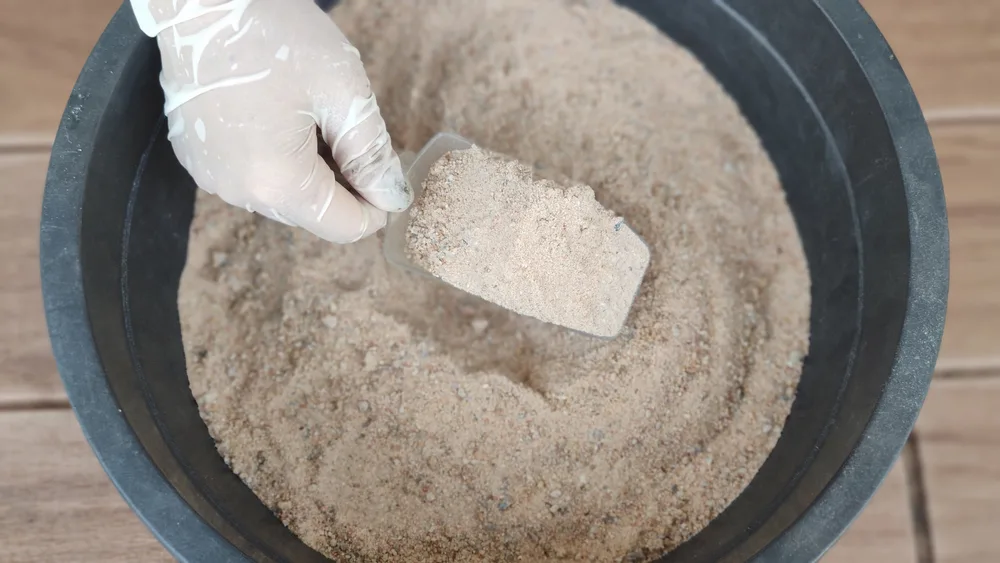
Coarse sand (also known as sharp sand and builder’s sand) contributes to soil drainage and aeration. It is inexpensive and very good for gardens in rainy environments, where poor drainage is an issue.
Perlite
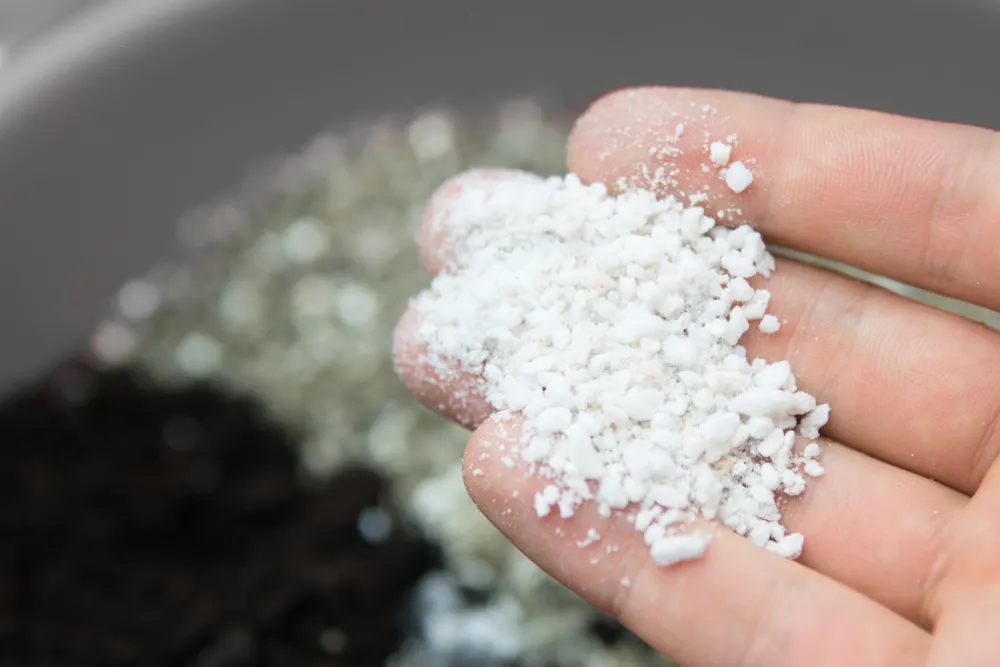
Perlite is made from heated and expanded volcanic rock. Like coarse sand, perlite provides stellar drainage and aeration but it is lighter and holds more air.
Vermiculite
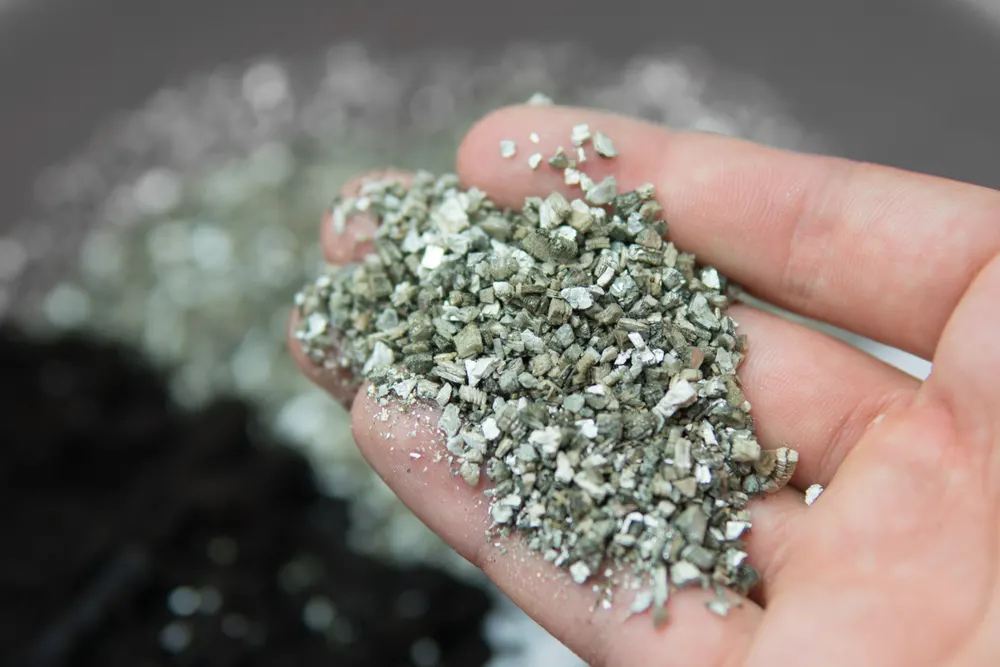
Vermiculite is a type of clay within the mica family that boosts drainage and aeration. Unlike perlite, it can also hold onto moisture and nutrients.
Coconut Coir
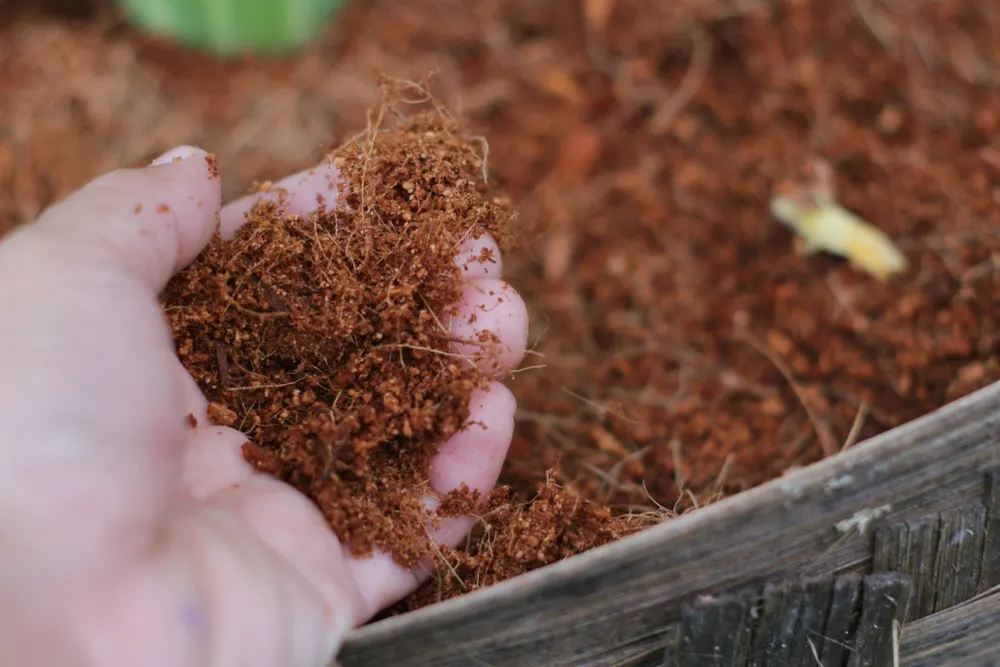
A more sustainable alternative to peat moss, coconut coir helps keep the soil moist. Coconut coir is an especially useful amendment when gardening in dry and arid settings.
Biochar
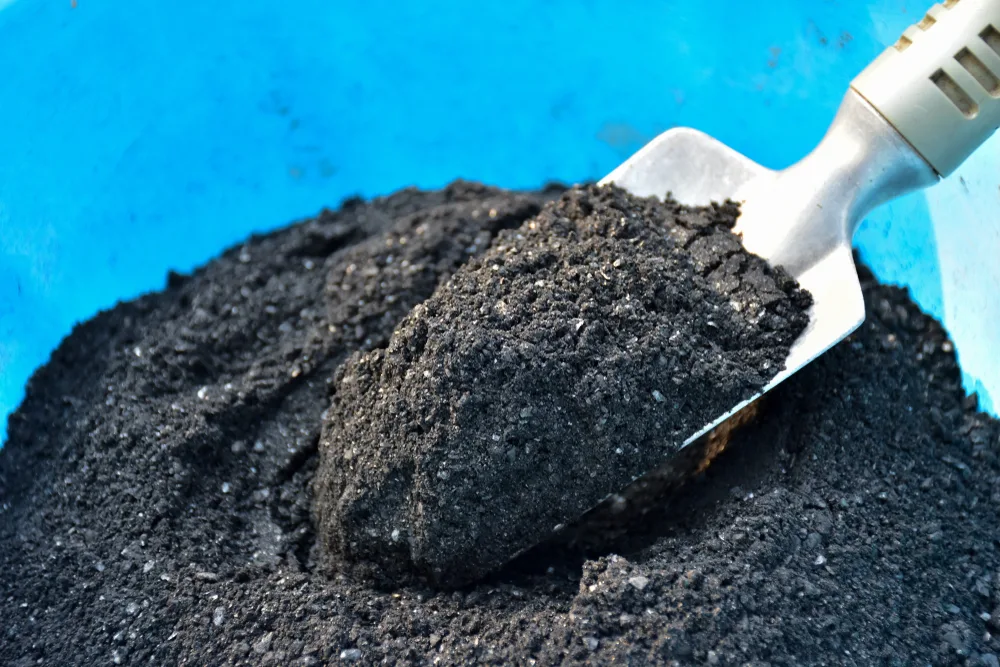
The byproduct of heating organic wastes in an airless environment, including biochar to your raised bed mix will improve soil structure and moisture retention with a little nutrient boost. Learn all about making biochar here.
Mycorrhizae
Mycorrhizal fungi have a symbiotic relationship with plants. When they colonize the rhizosphere, they make nutrients available to the plant roots; the plants provide the fungi carbohydrates in return. Good quality topsoil should already have plenty of mycorrhizae within it, but you can always add more when in doubt.
How To Fill Your Raised Bed For Cheap
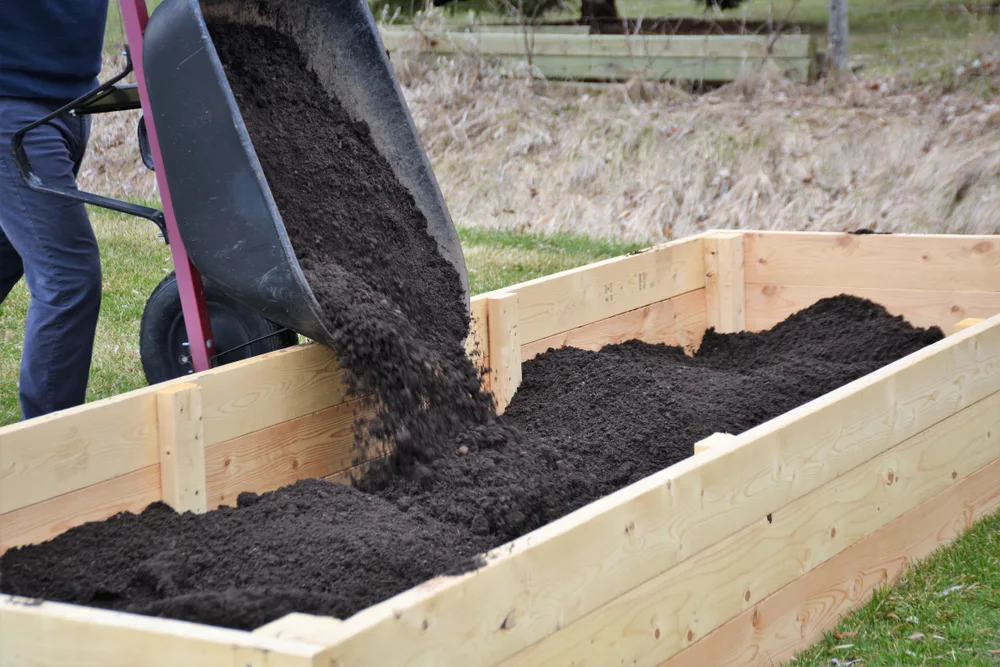
Once the raised beds have been built and all the ingredients for soil are at the ready, it’s time to start filling up your grow box.
Aside from using native topsoil and homemade compost, there’s another clever way to fill up your raised bed for cheap.
If you’re filling a really deep raised bed but plan on growing shallow-rooted crops (like lettuce, spinach, and strawberries), you can save on soil by adding biodegradable fillers to the bottom of the bed.
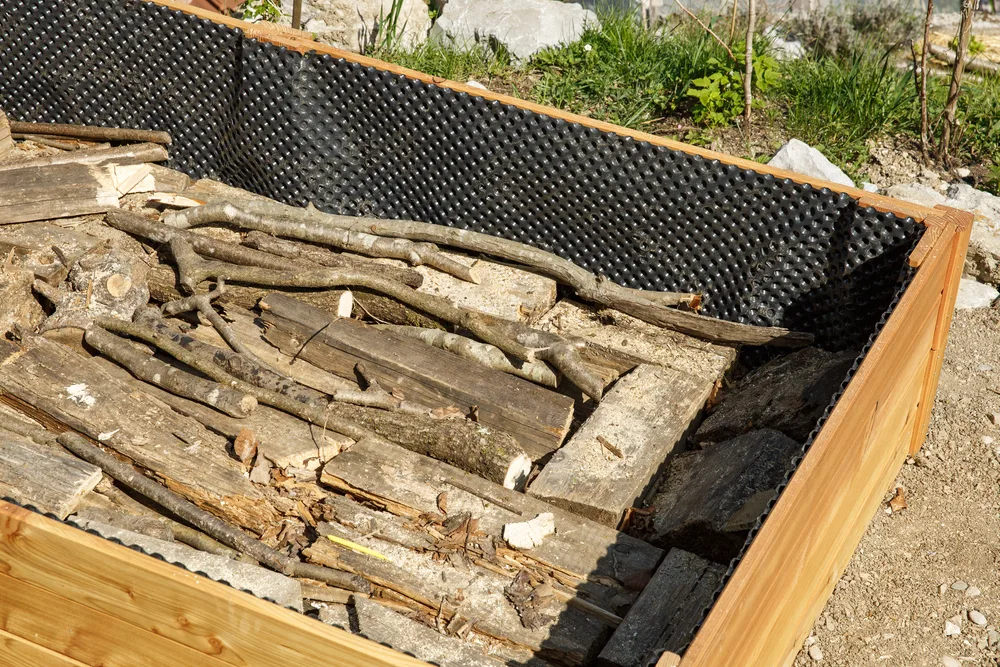
Use untreated and natural things like wood logs, branches, wool, cardboard, or wood pellets.
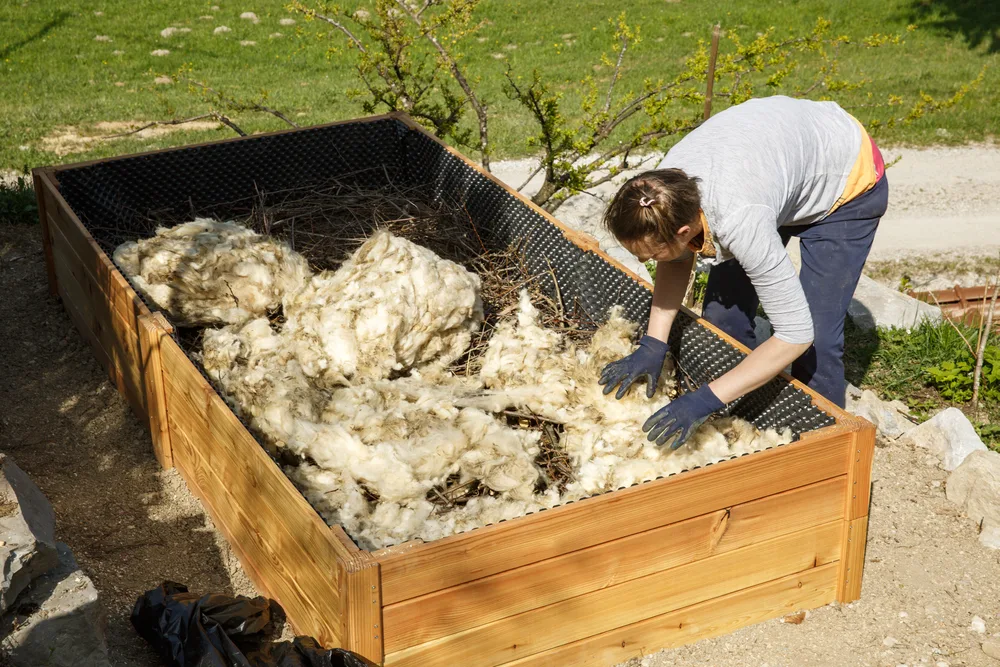
Pre-mix your topsoil, compost, and other soil ingredients together – keeping them properly portioned – by adding them, one at a time, to the raised bed. When you reach the halfway point, stir up the soil mix thoroughly. Repeat to fill the remaining half.
Fill up each bed within an inch or two of the top. Leave enough room to finish the bed with a generous layer of garden mulch.
Maintaining Healthy Soil
Caring for the rhizosphere of your garden beds is a smart investment that will save you loads of trouble in the long run. After all, you can’t have healthy plants without healthy soil!
To maintain a vigorous soil environment in raised beds season after season, nutrients will need to be replenished annually.
Rotating annual crops, boosting fertility with plant teas, adding more compost, and growing green manures in winter are some of the natural ways to improve the health of your soil.
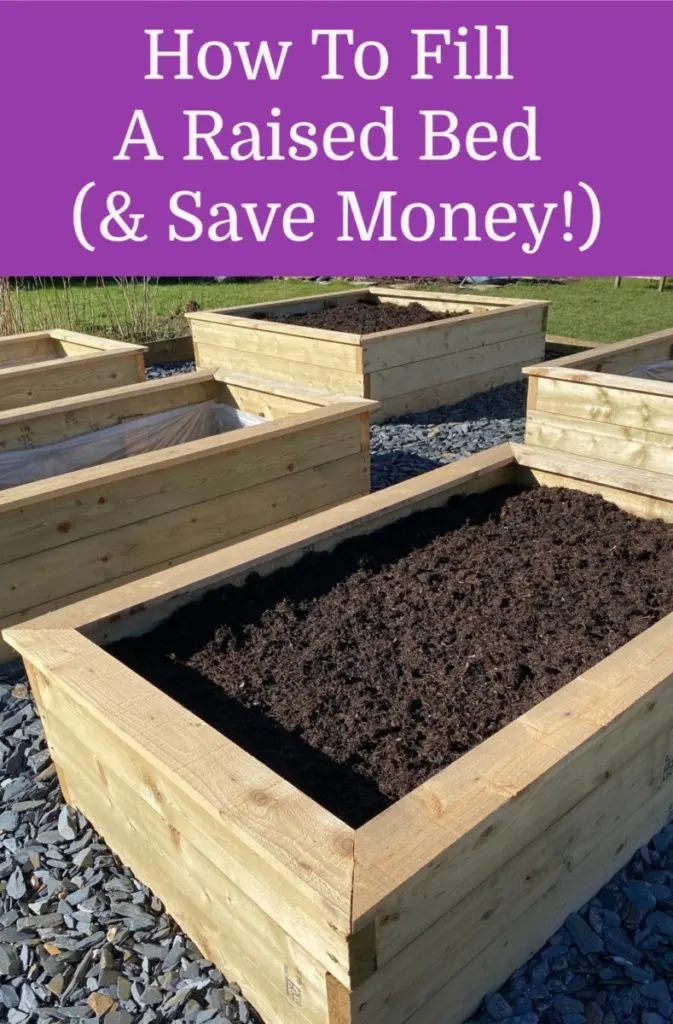

Get the famous Rural Sprout newsletter delivered to your inbox.
Including Sunday musings from our editor, Tracey, as well as “What’s Up Wednesday” our roundup of what’s in season and new article updates and alerts.


